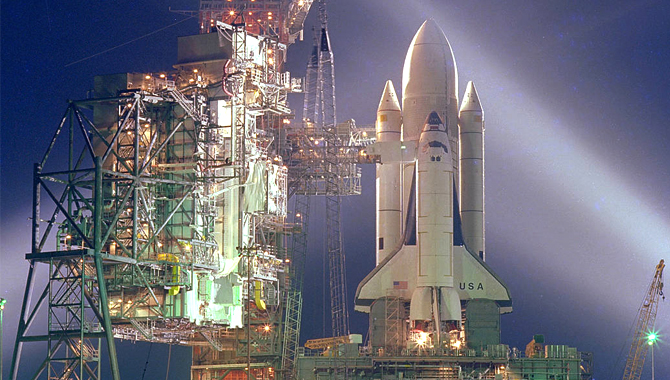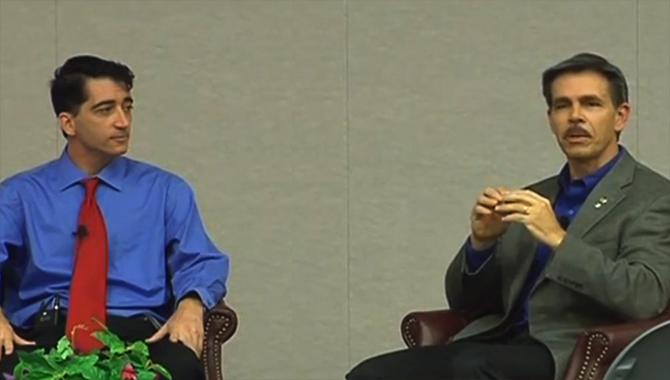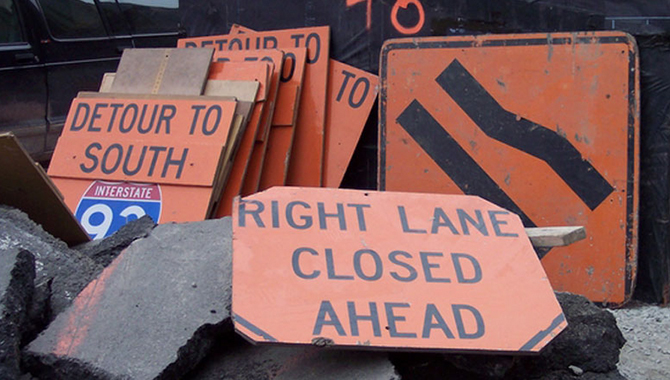
The space shuttle Columbia on Launch Pad A, Complex 39, before its first mission on April 12, 1981. The Apollo Challenger Columbia Lessons Learned Program (ACCLLP) featured an event, STS-1: Legacy and Lessons Learned, on this groundbreaking mission.
Photo Credit: NASA
Apollo Challenger Columbia Lessons Learned Program (ACCLLP) Manager Michael Ciannilli discusses a novel initiative to transfer knowledge effectively and put it to work for the future.
Ciannilli is the program manager for both the ACCLLP and the Columbia Research & Preservation Office (CRPO). At the CRPO, he handles all activities concerning the recovery and preservation of debris from the space shuttle Columbia. The original orbiter in the Space Shuttle Program (SSP), Columbia flew for the first time on April 12, 1981, when she lifted off from Kennedy Space Center (KSC) for a two-day mission known as Space Transportation System-1 (STS-1). Her final mission, STS-107, came to an end 22 years later when the spacecraft disintegrated during re-entry, resulting in the deaths of all seven crew members.
Since then, through the CRPO, Ciannilli has helped Columbia and her crew continue their work for NASA by serving as a resource for advancing the safety and reliability of future missions. Recently, he expanded his work with Columbia by introducing a new initiative designed to bring historic lessons to life in an innovative way that will increase the likelihood of mission success for the agency as well as commercial space companies. APPEL News asked Ciannilli to discuss his work as program manager for the ACCLLP and share how his efforts are transforming the concept of lessons learned into a powerful tool to support the future of the U.S. space industry.
APPEL News: How did the ACCLLP emerge from your work with Columbia?
Michael Ciannilli: When we stopped flying the Space Shuttle Program, NASA senior leadership asked me to lead a project called Forever Remembered. The intent was to create NASA’s memorial to the crews of Challenger and Columbia. It made sense for me to do this because in addition to managing the CRPO, I oversee the Challenger Office.
We built NASA’s public memorial for Columbia and Challenger at the Kennedy Space Center Visitor Complex. While I was working on this project, NASA was transforming KSC from a center that revolved around the space shuttle to a multiuser spaceport. Suddenly, the center worked not only government launch systems but also commercial launches and things like the Commercial Crew Program. So KSC was evolving tremendously and NASA was changing as well. I became convinced that Columbia and Challenger could play powerful roles in helping make those transitions successful. I pitched my vision for how we could do this to NASA senior leadership. They were interested in the concept and we worked together to refine the vision and the project. Then, in early 2016, the project was approved. It’s called the Apollo Challenger Columbia Lessons Learned Program. Yes, it’s a long name. That’s because it encompasses the entire vision for what we’re doing. I brought in Apollo because there are so many lessons learned from that period that we can share and apply to projects today. I also wanted to bring in Challenger so that we didn’t lose the lessons learned from that incident. Finally, I knew Columbia needed to be part of this so we could share the many critical lessons from that orbiter and her crew. NASA senior leadership from Headquarters and KSC supported the concept and approved it.
APPEL News: Is the ACCLLP already up and running?
One ACCLLP event, Apollo 1: To There and Back Again, focused on lessons learned from the first Apollo mission. In this image, KSC Director Bob Cabana, left, moderates a panel discussion with Ernie Reyes, retired, Apollo 1 senior operations engineer, and John Tribe, retired, Apollo 1 Reaction and Control System lead engineer. The event paid tribute to the Apollo 1 crew: commander Virgil I. Grissom, command module pilot Edward H. White II, and lunar module pilot Roger B. Chaffee.
Photo Credit: NASA/Kim Shiflett
Ciannilli: We started in January of 2016 and the program is now rolling out in phases. It’s an evolving program because there are several different things I envision doing. We started with lessons-learned events that showcase the value and relevance of learnings from Apollo, Challenger, and Columbia. The goal is to innovatively reimagine the history so that we can present the stories from these three programs in a way that makes them function as effective lessons learned.
The first event, which was held in 2016, was called The Apollo Challenger Columbia Lessons Learned Program. It started with a reintroduction of the work of the CRPO and then launched into the ACCLLP: what it is and how it will help projects and programs at NASA. The ACCLLP events are held in large rooms or auditoriums and are infused with multimedia. I try to involve people who are powerful speakers, and we then talk in an intimate and personal way about the lessons learned. So for the first event, I invited the final launch director for the Space Shuttle Program. He talked about Columbia and the work done at the CRPO with his support. I then explained that the CRPO is now part of the ACCLLP: it’s a function of the broader program. So that was our first event.
A few months later, I held a second event called STS-1: Legacy and Lessons Learned. I chose this subject because in addition to talking about mishaps associated with Apollo 1, Apollo 13, Challenger, and Columbia, I want to focus on the agency’s successes. This is important: you can learn just as much from what NASA did right as from our missteps. This event talked about the first flight of Columbia, which was a major success. I brought back key members of the original STS-1 launch team from the early 1980s. The goal was to create an exciting production through innovative use of multimedia plus speakers with powerful stories to tell. It wasn’t just a panel discussion. Some of the folks gave keynote speeches, some held intimate discussions with the audience. There was a lot of engagement. We talked about how we accomplished the first flow of a new vehicle, which included how we processed the vehicle and the launch. This was extremely relevant to people in the industry today because government and commercial launch providers now and in the future—like NASA’s Space Launch System (SLS), SpaceX, Blue Origin, and Sierra Nevada, among others—are going to be doing something very similar to what we did with Columbia all those years ago. The ACCLLP productions are based on historical events, but the focus is on what the teams went through, the challenges they faced, and the lessons they learned that remain relevant today. This provides enormously valuable information to people who are working space-related programs and projects right now.
APPEL News: Have you held any events since then?
Ciannilli: This past January I did an event called Apollo 1: To There and Back Again. This one went even farther back in time, and the speakers I invited took us all the way back to the 1960s! But they had such valuable information to share. I made a point of looping in all sorts of multimedia clips and audio that had rarely been seen or heard before so that it was clear: this event was different from other lessons-learned forums. Listening to the presenters who joined us from Apollo 1 made for an unbelievably moving and powerful experience as we heard their recollections of what it was to lose our first crew on the ground. We talked about the very early Apollo years and all of the lessons learned that came out of Apollo 1. Again, I want to stress that the conversation was relevant to the future, not just the past. Apollo 1 was a capsule, and we’re going to be flying capsules again. NASA’s Orion is a capsule. SpaceX’s commercial crew Dragon is a capsule. Blue Origin is working on a capsule. We’re going to be doing all the things again that Apollo 1 did—so we want to make sure we’re not reinventing the wheel. We can learn so much from what the Apollo folks did, both the good and the bad. The idea is to give this next generation the benefit of all the knowledge so that they’re standing on the shoulders, so to speak, of the legends of the past. The goal is to transfer their knowledge and put it to work for the future.
APPEL News: How have people responded to the ACCLLP events?
Ciannilli: I’m grateful to say they have been extremely well received. The same was true for our most recent event, America’s Spaceport: Integrating the Future. This one focused on how KSC is transforming into a multiuser spaceport. The event looked at all the different elements involved in transitioning KSC over 50 years from what it was originally into what it is today. We presented all the lessons learned from the process of transforming the center. This included teaching the audience how a spaceport works now because it’s so different from what it was a few decades ago. It was a living lessons learned example because it wasn’t just about the past, it was also about what we’re doing—and learning—today.
APPEL News: Is there any way for people to view or attend the events you’ve held already? Are you offering them elsewhere? Or are digital versions available to view?
Ciannilli: The live events are just one phase of ACCLLP. They’re also recorded in high definition. These recordings are currently in post-production. Eventually, people will be able to go online to see them and benefit from the lessons. So far, I’ve been holding the events at KSC. But I’ve spoken with people at other centers about the possibility of creating events that are designed around a topic that’s especially relevant to that center and holding the event at that center. ACCLLP is an agency-wide program, and my long-term goal is to transition into a model where ACCLLP events are held at centers across the country.
APPEL News: How do these live, multimedia-based lessons learned events complement the lessons learned tours you already offer on Columbia?
Ciannilli: When the CRPO tours began years ago, they were simply tours of Columbia artifacts. That’s changed. Now I give a whole lessons learned presentation. People come to the Columbia Preservation Room, where I offer a storytelling experience that uses the artifacts to teach the lessons learned. I take them through the accident and what the Columbia artifacts taught us about the accident. We discuss issues like the schedule pressures and the budget. We talk about launch day and any missteps that were taken. We have a very frank discussion of what was done wrong and what we learned from it. And we discuss the return to flight. Basically, we cover all the lessons learned through the entire experience, including what went into the Columbia Accident Investigation Board (CAIB) report and their findings. The goal now is to increase the number of tours available to people who visit KSC and to maintain this strong emphasis on the lessons learned. Hopefully, I’ll eventually be able to take the artifacts on the road to people who can’t come to see Columbia, but we’re not ready for that yet.
APPEL News: What is your ultimate goal for the ACCLLP?
Ciannilli: Above all, I want Columbia and her crew to touch people’s hearts and minds. And I want the Apollo and Challenger stories to do the same thing. That’s where innovation comes in. I want to approach the stories and the lessons learned from a different angle. I want to offer the technical information but also connect with the audience on a human—emotional—level. To me, that’s so powerful. It creates lasting learning. When people experience an ACCLLP event or tour or training, I want them to feel a call to action. I want them to walk away inspired to make a change. To do something different. Maybe that means double-checking their work. Or spreading a culture of openness and open communication. Or being extra diligent or extra aware. Every time I produce one of the events, I try to make it come alive. There’s a lot of technical information, but I want to convey it in a way that people feel it and walk away with it still in their hearts and their minds.
APPEL News: You clearly love what you’re doing.
Ciannilli: I’m incredibly honored and humbled by this work. I see so much possibility in the lessons learned from Columbia and Challenger—from the sacrifice of those spacecraft and their crews—to change the future for the better. As someone who lived through Columbia very intimately, I’ve seen over time the positive impact of taking a dark experience in history and bringing it into the light, so to speak. The opportunity to make something powerful and positive out of a tragic event is transformative for the entire agency, I think. I’m very grateful for the opportunity to put this vision into reality so we can learn from the past to build a better future.
APPEL News: Thanks for all of the time you’ve taken to fully explain this innovative program. Is there anything you’d like to add?
Ciannilli: I’m very grateful to NASA senior leadership for their support of this program. They have worked hard with me to make this program possible so that the powerful lessons learned through the decades can continue to support the agency moving forward. Without the support and advocacy of NASA senior leadership, the ACCLLP would not exist.
___
This interview is the second in a series of conversations with Ciannilli about his efforts in helping Apollo, Challenger, and Columbia continue their work to inform, inspire, and advance the future of safe human spaceflight.
Read Part One of the APPEL News interview with Ciannilli.
Visit the CRPO website to learn more.








